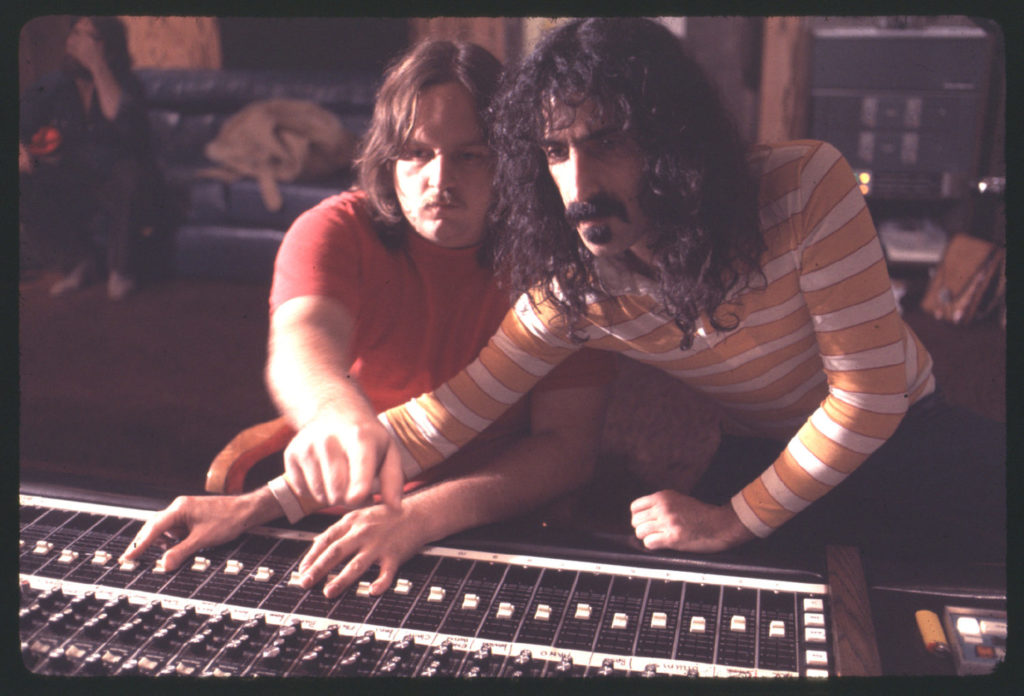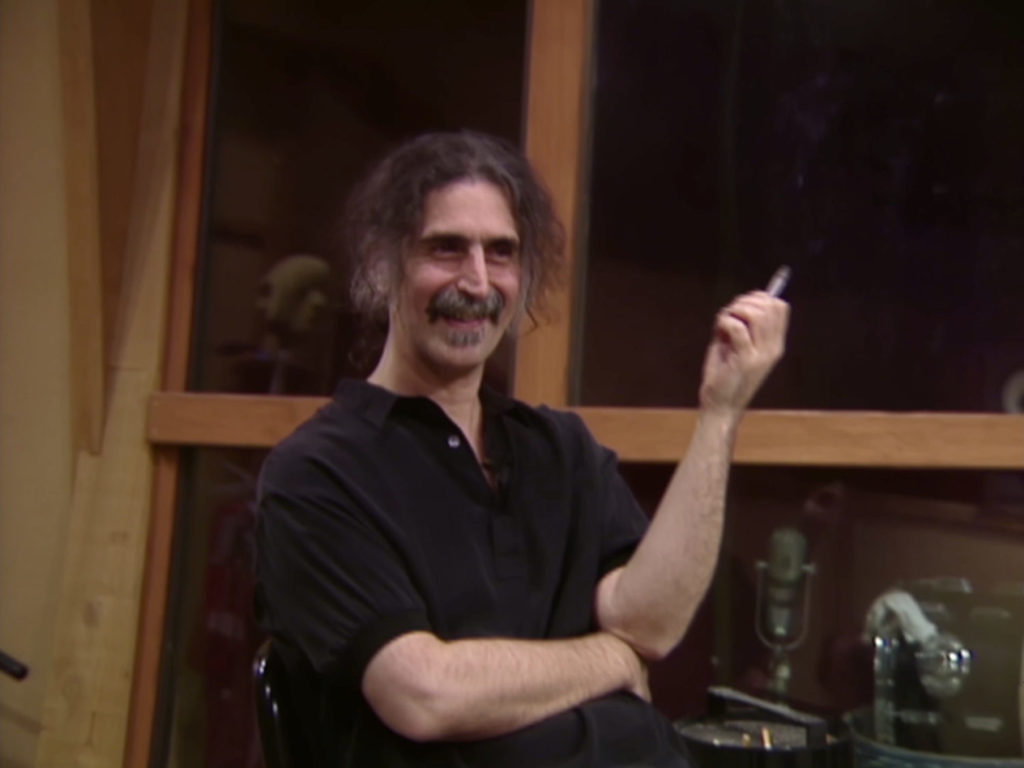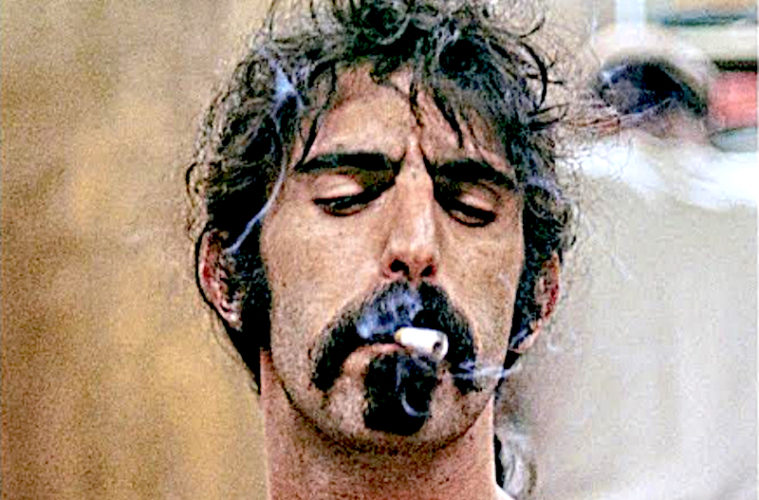Frank Zappa was a musical non-conformist who scored a hit with one of the most culturally reflective and simultaneously campy pop songs ever. His music was excessively trippy, but he was anti-drug. He was outspoken, yet he was an enigma. Capturing the contradictions of such an iconic -and iconoclastic- figure is no easy task, but Alex Winter’s new documentary ZAPPA (Magnolia Pictures) comes pretty darn close.
Winter, best known as Keanu Reeves’ co-star in the Bill & Ted movies, is an accomplished director and producer in his own right (with credits including B-movie horror classic Freaked and acclaimed docs about child stars and the dark web). The filmmaker, who knew Frank’s son Ahmet prior to the project, was a big Zappa fan and his passion for the artist led his widow Gail to grant him full access to the legendary Zappa vaults underneath the family home in Laurel Canyon.
“He [Ahmet] politely let me know that she was known to not say yes to these things,” recalls Winter when we speak by phone during advance promo for the film. “We hit it off … I knew that she’d had terminal cancer but I did not know -I don’t think anyone knew- that she had so little time left. We started doing interviews with her at the beginning of 2015 and filmed her all the way through ’til basically right before she went into the hospice.”
Gail Zappa died of lung cancer in Oct. 2015, and thankfully she not only said yes to Winter, but trusted him, as their conversations provide the most revealing aspects of the film. From the beginnings of their whirlwind romance to the challenges that she dealt with later as the partner of such a complex artist— her husband devoted hours to his intricate music, traveled the world on tour and lived what everyone admits was a non-monogamous rockstar lifestyle. To Winter’s credit he creates an honest and multi-faceted portrait here, one that highlights Zappa’s genius but also his human flaws. Other talking heads in the film also provide unfettered takes on the man, including friends and collaborators Alice Cooper, Mike Keneally, Ian Underwood, Steve Vai, Pamela Des Barres, Scott Thunes, David Harrington and especially percussionist Ruth Underwood, to name a few.

(Yoram Kahana/Courtesy of Magnolia Pictures)
As the movie chronicles, Zappa’s ties to Los Angeles run deep. After moving to L.A. at 18 years old, he built a following with his band, the Mothers, at venues such as Cheetah Club and The Whiskey, and years later his work with the Los Angeles Philharmonic Orchestra solidified his local ties. He is buried at Westwood Park Memorial Cemetery.
Winter says that most of the footage seen in ZAPPA was previously unseen, which makes it a real gift for his fans. The director spent hours upon hours going through materials deciding what to highlight, and he worked on preserving and digitizing it as well via money raised through a Kickstarter campaign. The result is a proper chronicle of the musician’s career with lesser known but equally pivotal moments of inspiration and creation giving a fuller picture.
With so much material to work with, Winter’s task was daunting to say the least, but his approach allowed for nuance. “We had an enormous amount of media to look through and a lot of options,” admits Winter. “The interest I had in telling the story was not trying to create a kind of definitive, all-encompassing statement about Zappa or his music which I don’t think is doable in a film, probably not even a series. The editor -Mike Nichols- and I were very focused on Frank’s interior life, his emotional life, and the pull of our narrative was on that.”
Notably, the vaults and the estate in general were the subject of the Zappa children’s emotional lives just following Gail’s death, when it was revealed that she left Ahmet and youngest daughter Diva in control of their father’s estate, with smaller stakes and less decision-making power to the two older siblings Dweezil and Moon Unit Zappa (the latter of course heard on Zappa’s best known song, “Valley Girl”). The family turmoil was played out publicly in local and national media, and professionally as well— in response to issues over playing his father’s music under the “Zappa plays Zappa” moniker, Dweezil even re-named his show the “cease and desist tour,” referencing legal paperwork he received from the Zappa trust before they reached a settlement last year. He was in the midst of a tour under his own name, playing music from his father’s revered Hot Rats album before the coronavirus forced him to postpone the dates.
Ahmet -who serves as co-producer on ZAPPA and was on the interview call with LA Weekly as well- says that things are “light years better” between his siblings since the settlement and announcement that they would deal with things privately. Neither Moon nor Dweezil have shared anything about the film on their social media accounts as of this writing, however. In any case, fans of Frank’s family will be happy to see his dad life get a decent slice of time, with scenes of the period when the kids were growing up via home video footage. Seeing the artist as a father, even an imperfect one whose offspring wanted more of him (as was the case when teen daughter Moon recorded the SoCal anthem “Valley Girl” with him in the ‘80s) provides a full-bodied take on who this man was.

(Dan Carlson/Courtesy Magnolia Pictures)
Ironically, for non-fans, the Top 40 hit might be the only Zappa composition they know. That song, coupled with his wacky album covers and often sardonic song titles (”Don’t Eat the Yellow Snow”) released before and after, probably made those who hadn’t dug deeper assume he was a silly novelty act. That partially changed when Zappa got involved in politics and fighting against censorship, making appearances at PRMC hearings and leading many to rediscover his avante-garde brilliance. Of course, audio-files and music obsessives have revered Zappa and his innovation in recording techniques (which the vault’s progression of archival footage illustrates) and composing since the ’70s.
To this day, Zappa evokes weird, wacky, heady, satiric and oddly sexy imagery and soundscapes. His image- lanky, shaggy, mustachio’d and wild eyed- definitely contributed to the mystique. His appreciation for visual storytelling (his work with animator Bruce Bickford as seen in the crazed classic 200 Motels -and highlighted in the film- is simply stunning) played into this too.
But the most compelling takeaway from this deep dive into Zappa-dom is less about what we, the viewers and listeners saw in his work, and more about what he did, and more importantly how he put it all together. His cerebral and seemingly spiritual approach to composing found full splendor in an orchestral setting, and as the film unfolds, it was clearly something he worked towards in various incarnations throughout his career. His virtuosic appearance at 1992 Frankfurt Festival, where his music got the symphonic treatment near the end of his life, encapsulates the wonder of this vision and makes for a fitting climax. He died of prostate cancer a year later.
“It was important for people understand the life of a composer,” Ahmet says of the film’s focus. “That’s different than being in a rock n’ roll band. In this movie you get to see all of Frank’s superpowers as a creative force.”
Advertising disclosure: We may receive compensation for some of the links in our stories. Thank you for supporting LA Weekly and our advertisers.

